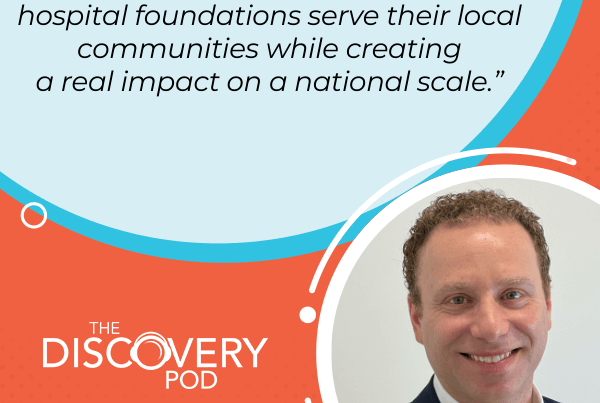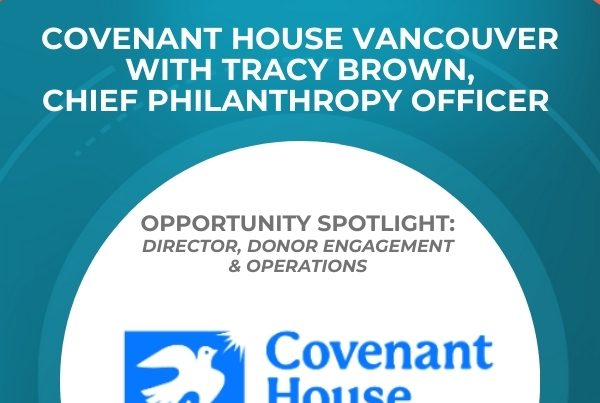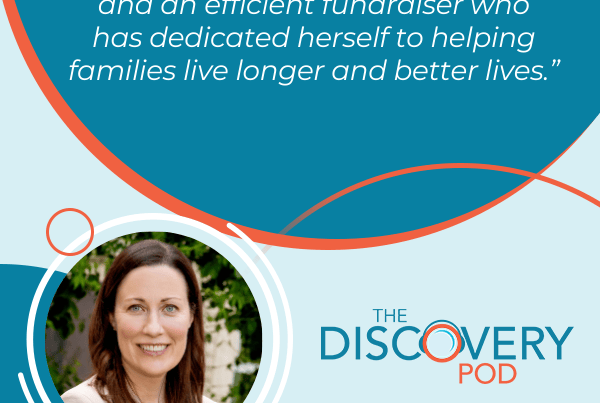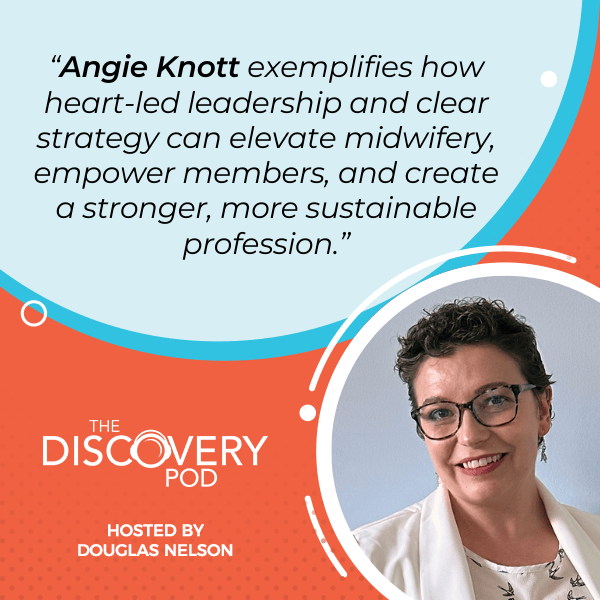
In a healthcare landscape under strain, balancing immediate member needs with a long-term strategic vision has never been more critical. Angie Knott, Executive Director of the Midwives Association of British Columbia, shares how she leads a profession facing burnout, staffing shortages, and under-recognition while championing parity of esteem, sustainable midwifery care, and stronger integration into the healthcare system. Drawing from her own leadership journey, she explains how people-centred strategies, clear priorities, and member engagement can turn challenges into opportunities and build a vibrant future for midwifery.
—
Listen to the podcast here
Balancing Member Needs & Strategic Vision With Angie Knott, Executive Director, Midwives Association Of BC
As part of our Women’s History Month series, we’re proud to spotlight leaders making a difference in health and equity for women across Canada. This episode’s guest is Angie Knott, Executive Director of the Midwives Association of British Columbia. With many years of nonprofit healthcare leadership, Angie brings a people-first approach and a strong commitment to advancing midwifery care and health equity throughout the province.
Her experience spans executive roles in health organizations and founding a consulting practice focusing on governance strategy and team development. She’s passionate about building strong values-driven organizations that advance positive change in their communities. In this episode, we talk about using the strategic plan as a tool to move the organization forward, the challenge of serving individual members and the profession as a whole at the same time, and invigorating a team after turbulent times. Angie is an experienced leader with a lot of wisdom and a lot of great advice. You won’t want to miss this conversation with Angie Knott.
—
Welcome to the show, Angie.
Thanks for having me.
Angie, I’m really looking forward to the conversation we’re going to have. We’ve had other association leaders on the show over the course of the last number of years but it’s been a real pleasure getting to know you, your leadership style and your organization. I’m looking forward to sharing your expertise and your perspective with our audience. Are you ready to go?
Sounds great.
Midwives Association Of BC: Who They Serve & Their Mission
Alright, tell us about Midwives Association of BC, who you serve and how you do your work as Executive Director.
The Midwives Association of BC is a professional association for registered midwives in the province. We represent a pretty diverse and deeply committed profession that’s really integral to the BC healthcare system, specifically in the maternity area. Midwives are autonomous. They are a regulated primary care provider, and they provide full scope perinatal care. What that means is from pregnancy through birth, and then six weeks postpartum as well. I came into the role in a pretty significant time of transition for the midwives. It’s been it’s been interesting so far.
I think anybody who’s paying attention to healthcare anywhere in Canada knows there is a tremendous amount of upheaval and stress and strain. How is that showing up in the work of midwives here in British Columbia?
It is definitely a challenge, as I’m sure most people have heard. There’s a lot of conversation about the challenges in healthcare and that certainly translates to maternity care as well. We’re hearing a lot of issues with facilities closing or closing their maternity wards because there’s not enough healthcare personnel. We really think that midwives can be part of the solution to that problem where there aren’t enough other healthcare providers.

Midwives Association of BC: Midwifery is a tough profession. Babies don’t have scheduled arrivals; you can’t choose. There’s a lot of on-call work that isn’t always compensated.
At the same time, midwives are also facing those same issues. They are overworked. They are burning out. Midwifery is a tough profession. Babies don’t have schedules. They don’t pick when they’re coming and you can’t choose. There is a lot of on-call work that is not always compensated for midwives. Certainly, some challenges and we’re seeing some burnout in the midwifery space around those pieces. The model of midwifery is changing as well. The way that midwives practice has changed, and that’s not always reflected in contracts or how midwives are compensated.
Navigating Healthcare Challenges & Building A Sustainable Future For Midwifery
I think one of the really interesting things that you’ve brought to the table and on behalf of midwives in the province, has been this idea of how do we make this profession sustainable? I think that’s a question that many Canadians and anybody working either in the philanthropic space or in the association space in healthcare, is how do we improve this system so that it can keep going and keep delivering for people who need it and when they need it. What does being sustainable as a profession look like for midwives?
I think I touched on it a little bit in that burnout piece. It really is ensuring that there are enough midwives, ensuring that midwives feel well supported in the profession and being more integrated into the healthcare system as well. We’re seeing some of that integration through those different ways of working through things like service contracts but it’s not quite there yet.
There's growing recognition of the value and role midwives play in healthcare. This is a big part of our advocacy work in the near future. Share on XAs a female-dominated profession, it’s certainly been a fight for midwives for some time. I don’t think it’s quite done yet. I think there is more and more recognition of the value and the role that midwives can play in the healthcare system but it is a big part of the advocacy work that we will be doing in the near future.
There’s so much of an issue of parody of esteem. What is the role of a midwife in the care team that an expectant mother, maybe the service she may be receiving. How does the association address that issue of parody of esteem and the role of midwives in the system?
Yeah, so I think that’s a, that’s a big question that we’re looking at. The key piece is midwives in leadership roles and really ensuring that at the tables where decisions are made and where choices are being put forward, that midwives have a voice, and that they have the opportunity to really ensure that people understand what midwifery is about and what midwifery practice looks like.

Midwives Association of BC: Midwives have a voice. Having them in leadership roles provides the opportunity to ensure people understand what midwifery is about and what midwifery practice looks like.
I think that not everybody understands the full scope of midwifery care and the pieces where midwives can really play a role. I think sometimes there’s some misunderstanding in terms of what midwives do and do not do. The role of a labor and delivery nurse, for example, versus a midwife. Those leadership roles for midwives will be a key piece that we want to ensure happens so that people really do understand.
The association role, on the other hand also, is more of that public awareness so that folks who are planning on having a baby or are pregnant are able to access the care of midwives. Currently, about 30% of births in BC are midwifery-led, but we’d certainly like to see that increase because it is a really wonderful, very holistic experience to work with a midwife during that time.
A Leader’s Journey: Why Angie Knott Chose Midwifery Advocacy
I am going to ask what I think many of our readers may be thinking after the first couple of minutes of our conversation, Angie. You’ve come to this role relatively recently. You’ve got a deep experience in association leadership. What is it about an organization and a profession that’s dealing with burnout, fighting for parity of esteem, taking on some structural inequities in how it’s funded and how it’s positioned in the care system? What is it about that this is the job I want to take on?
I think fundamentally, I enjoy a project but also what really drew me to the MABC is the way in which midwives work, that really heart-led caring approach, because I think that’s the approach that I take to leadership. It felt like just a really good fit and a good connection. I have a personal connection to midwifery because both my children were delivered by midwives. It felt like the right place at the right time. So far, it’s been an adventure, but it’s been really fulfilling and really good. I’m really hoping that through the expertise that I have in leadership and governance, in managing transitions, I can really help to stabilize the association and help it to flourish and to help midwifery advance in this province.
New Beginnings In Leadership: Adapting To Different Organizational Dynamics
One of the things that’s always top of mind for me when I get to talk to a leader who’s been a leader of a number of organizations or a couple of organizations, is how is this time different? Thinking back to the first day, hand on the door, when everybody used to go into the office every day, hand on the door, you pull open the door, what is it like coming through the door? How is it different when you’ve been an executive director, when you’ve been a leader of an association before coming into your new role here at MABC?
There’s always a little bit of same and a little bit of different. Different is the place of development where the organization is. It is the team. Team dynamics are always different because, depending on how much of a team you inherit, how much of the team you have to build, and at MABC, it’s a little of both. There are folks that have been there who are we’re learning how we all work together and what that looks like. At the same time, it’s working to develop your own culture and the culture within the team and bringing on some missing pieces.
Always a little bit of the same and a little bit of different. It’s been, so far, a really interesting time. The internal dynamics and building that internal culture is one of the things that I really enjoy doing. Even in the relatively short amount of time that I’ve been at MABC, seeing some of those changes is really exciting.
Was there something that you brought from your previous role that was particularly helpful as you came through those doors in the first few days, first few months?
I think every previous experience we have helps set us up for the new one. I know that’s really vague.
Every previous experience has helped set us up for the new one. Share on XIt’s also true.
It is true, but it what I mean is that I consider myself a lifelong learner, and I always like to pick up new bits and pieces of information. As in my previous executive director roles, if there were things that I didn’t know how to do or I hadn’t done before, I learned those pieces. That positioned me better in this position to already have some of those. It’s similarities.
Working with boards, no matter what that board is, and specifically in the healthcare space, we are always working with healthcare professionals who are so passionate about their profession. There’s also a challenge sometimes in that. They have specific expertise in their field. They’re not necessarily governors or folks with deep governance experience. It’s always interesting to see where folks are at, and then how do we develop some of those pieces.
The Continuous Learning Curve: Unlearning And Adapting In New Leadership Roles
All of our experiences make us who we are now. The learning you’ve acquired over your years as an executive director in other organizations all helps. Was there anything that you’d learn that you needed to unlearn or you needed to set down or something you were aware of that you couldn’t bring with you through this door as you started at MABC?
I don’t know if it’s unlearning or new learning, but I think the challenge, particularly when you’ve worked with one profession for a long time, is then coming in learning the nuances and the differences with the next profession. I think that’s been the biggest learning. It’s really learning. I had personal experience with midwifery, but that was some time ago. Midwifery has changed. A lot of the work has been building and understanding the specificities of the profession you’re working with, whether it’s through how their government funding works. The previous profession I worked with was entirely member-funded. There’s always going to be those differences.
I think those are the keys for success. You come in with a specific skillset. Whether that is team building or governance and certain things, it will carry across, but it’s really being committed to really, truly understanding what the specificities of the group you’re serving are. I’m probably still in that phase of really truly learning.
The one thing that I’ve learned over time in doing some contract work around membership is the importance of really truly connecting with the members. That’s probably something that I could have done better in previous roles. It’s a focus for this role, really making sure that we’re connecting with the members, that we’re really understanding them, that they know that we are there to serve them and really work on their behalf.
Serving Members Vs. Advancing The Midwifery Profession
As you’re saying that, I’m reminded of a conversation I had with a mentor of mine as I was moving from leading one health foundation to another health foundation. She said, “You need to be aware that these organizations are likely to be similar enough to be dangerous. You may take some things for granted because this is the way it worked at the old place, but your new team does not ever want you to hear you say, ‘At my old job, we do this.’ that’s not going to work.” Being aware of what you don’t know and what you need to be focused on learning is so valuable for leaders coming into roles.
Another part that I want to dig into a little bit and get your perspective on that I think it’ll be particularly helpful for many of our audience is the balance between service of members and service to profession, and the role of leadership that you play as executive director of the association. You serve at the pleasure and you exist to advance the profession and the individual professionals at the same time. Through that service, you have to lead. How do you make sense of that? How do you square that circle?
It’s an interesting balance. Fundamentally, the key and the thing to remember is the membership and that all the work that I and the operations team do really is to ensure that our members are happy and thriving and able to serve the clients that they have. At the same time, you’re right. The members and individual practitioners are in the trenches. They see the day-to-day, the challenges of I’m having this issue, or this is happening or I don’t have adequate funding for X, Y, Z, or whatever it may be. The role of the association is to be able to zoom out and to take that 10,000-foot in the air view of where we are in terms of the profession currently?

Midwives Association of BC: The role of the association is to zoom out and take that 10,000-foot view of where we are in the profession currently, where we want to go, and what we’d like to see. This must be informed by the desire and direction of the members.
Where do we want to go? What would we like to see? That has to be informed, obviously, by the desire and the direction of the members. At the same time, there’s an advantage to sitting up higher in that 10,000-foot area, and working with boards, particularly those healthcare providers who, at the same time, they end up wearing a little bit of two hats.
One is that in the trenches, I am there I day to day but at the same time, taking them to put that 10,000-foot view hat on. It can be done, and they often do a really great job, and they are able to zoom out. The role of the executive director really is to help them, to help them navigate what does that look like in terms of the long-term visioning and the strategic planning and what I like to refer to as the juicy work of the board. That idea of let’s come in, let’s talk about where are the issues, where are the pain points? Where do we see the association in the future?
It’s interesting to think about that you’re describing it as a single role because you experience it as one, but from the outside, it really does seem like two distinct responsibilities and accountabilities. How much of it is making sure that as your board members and as your memberships are switching between being doing the work, providing care and then coming up to that level of the association of those 10,000 feet, as you say.
How much of your role and the role of your team is about just ensuring the continuity of the conversation? If you’ve got board members and members who are bouncing up and down, it may be hard to look down the road five years if half your board members are on call during the meeting. How do you think about that continuity that you provide in those issues, or to those issues?
I think the simple answer is planning, be it strategic or operational planning and the continuity is in making sure that everybody is working towards the same goals. Those goals are those ones that are set out in the strategic plan. Making sure that the work and that the operations team really sees how each of their individual pieces play into advancing that goal, as well as making sure that the board and the members understand how we’re also working towards those pieces and having a strategic plan that can be operationalized, that can be put into an operating plan. That’s where your continuity really comes from.
Continuity ensures everyone works towards the same goals—those set out in the strategic plan. Share on XEverybody galvanizing around that shared goal, whether it’s from down in the trenches or higher up above. That’s why that strategic plan is so important. It’s the guiding paper that shows everybody what we’re actually working towards, and then you take it from two sides of the coin. The board really setting that direction and saying, “This is X where we’d like to get to,” and then the operating team saying, “Here are ideas for how we get to X.” It really does all revolve around having a set strategy and making sure that everybody understands the ultimate pieces that we’re working towards.
You describe it, it sounds so perfect and so straightforward.
It’s not.
What I really like about the way you describe that, particularly the use of the strategic plan or a strategic framework, is as a tool. As the leader, you can use that as a tool to frame the discussion with the board, to set context around the conversation, to use it as a way to frame, “We’ve decided the following three things. Now we’re going to talk about this fourth piece here.” Thinking of the plan, not just as a document, but as a tool. I think that’s really good advice you’re giving to other executive directors.
When it’s used as a tool and when your team, and by team, I specifically mean the operational team here, also understands that piece. Depending on how whether you’re a small team or a big team, everybody does a piece of the work. I think creating a culture within the operations of the organization where everybody understands how does my little piece, whether it is finance or program development or whatever it may be.
If they understand how that works towards the end that we’re working towards, it helps to bring the team together. It removes silos within the organization because the team is all working towards that same goal. I love using the strategic plan as a tool. I love ensuring that even in a staff work plan, they understand that goal X that I’m trying to accomplish this year relates to this pillar of our strategic plan.
One of the things I noticed in our conversation so far, Angie, almost all of your answers begin and end with a reference to the people involved. Is it as simple as healthcare and organizational leadership is just about the people?
To me, yes. I believe that in any service-based organization, you’re only as good as your people. Your people really, truly are your biggest asset. It’s really important to remember that, especially when things are not going so well. If you’ve got a good, strong team that’s working towards those goals and they’re all gelling together, it just makes it that much easier. I am the kind of leader that will always put my team ahead, in the sense of I want the membership and the board and everybody to understand the importance of the people that are working towards those goals. For me, 100%, the people are what make or break it.
Navigating Team Fatigue And Prioritizing Change
It’s an interesting challenge I see, getting to talk to a number of new leaders or new to their organization leaders, particularly in organizations where there has been upheaval, where there has been a lot of change. You come as the new leader with a clear mandate from the board to get things right and get the right team in place and get moving down the trail.
Oftentimes, leaders will come into a situation where the team is very tired and often, there have been people performing more jobs than what they’re hired to do because the absence of a leader, or there may be other absences or vacancies on the leadership team at the same time. You can come in with a lot of energy as the new leader, like, “I’m here, let’s get to work.”
Everybody’s like, “We’re exhausted. We’re tired. We need a break.” How do you think about that role as the leader coming in and with that energy, with that verb of, “This is new and everything I’ve learned before, I’m going to put into place. Here we go.” How do you balance that with the situation you find?
It’s definitely a balance. As much as I think a lot of people who end up in the leadership roles, whether it’s the executive director, the CEO, whatever it is, I think we come with a certain energy, a certain, “I want to get things done.” It is finding that balance and it is taking some time to really understand where you’re at. I joke every once in a while that if I had a magic wand, I could just wave it and everything would be perfect. It’s really understanding and that takes time.
In any service space or organization, you're only as good as your people. Your people truly are your biggest asset. Share on XIt does take a little bit of it in internal looking inward and looking and talking to the people, understanding where they’re at, where the challenges are what’s been good, and then prioritizing, which is not an easy feat because I think by our very nature, we’re solution-driven and we want to solve all the problems.
It really is prioritizing what comes first. In looking at our team specifically, it was where are the biggest gaps in terms of staffing? What is priority number one? Which one is the one that has to get filled right first? People are carrying weight of multiple departments or whatever it may be. You take it from there. I think the balance and the challenge and you’re not always going to get it exactly right, but really is how do you prioritize, how do you pace and it really is like putting a puzzle together a little bit. Which piece has to come first and which piece has to come second? It’s because things often are so interlinked.
You’re also managing the expectations of your membership, who have seen things maybe not going so well, and now you’re coming in and they’re like, “Where are these changes?” It’s a balance of doing things correctly, but at the same time making progress and ensuring that the team is in place. The approach I took was first, let’s figure out which ones are the critical pieces of the team. Let’s put those pieces in place. The next step is where are the really critical issues that we have to fix? Whether that is in policies that have led to issues with further members or what does that look like from the governance standpoint?
It’s a balance too and really understanding the level of comfort, for example, of your board. Is your board comfortable with we are going full speed ahead, 100 kilometers an hour, and we’re making all these changes. Are they more comfortable with something in the middle? What does that look like? It’s a lot of conversations, especially early on with the right folks, with learning some of the historical pieces. Why have certain decisions been made or why have we done certain things a certain way? Your relationship with your board chair or co-chairs, in my specific circumstance, is really important. That ed co-chair relationship and having open conversations to understand where they’re at and the comfort of the board in moving forward is going to be a key piece as well.
Often, in my experience, both when I was in role and now getting to work with a number of organizations through my work here at The Discovery Group, it’s a very uncommon board that is unified and whether they’re ready to maintain the status quo or change everything. There’s often quite a spectrum of opinions there, which is I think probably the hardest thing for particularly first time leaders reporting to a board to manage.
You’ve got board members who are like, “Everything’s been going pretty good. We had a few bumps, but we just need to get back to what we were doing and stay focused.” There are people there, others on the board that may be wanting to revolutionize things, revolutionize how the profession is viewed or how it operates. As the ED, you hear them both and they both have one vote, and you’re like, “My goodness.” It does come down to that relationship with your chair or co-chairs, as you say.
That relationship, but also taking the time. This is a practice I started in one of my previous roles, but have really carried it forward with more systematically in terms of the relationship with the board. I like to schedule a one-on-one with each board member roughly every six months. When you’re just meeting in board meetings, yes, your chairs, whoever’s on your finance committee or your governance committee, you get to talk to those folks a lot. Your board members at large, you don’t often get to know in a context other than board meetings where they may or may not speak up.
We’re talking 30 minutes. These are busy folks. There are a lot of them. We’re a board of eleven, currently. Just getting a chance to get to know them, ask them some of those questions like, “What are your hopes? What would you like to achieve while you’re on this board?” That gives you a good perspective. Everybody comes in with a specific focus area that they’re interested in. It gives you a little bit of a chance.
It’s that idea of legacy like, “When you leave this board 3 years from now, 5 years from now, whatever it may be, what’s the mark that you would like to have left on the association or the profession?” Also, asking them about are there areas that you’re really particularly interested in, or do you have skillsets that we don’t know about?”
The interesting thing that I’ve learned is a lot of midwives came into midwifery later in their careers. A lot of them have had a previous career. They bring really interesting skillsets, whether it’s finance or communications or whatever it may be. Finding what are those pieces that your board members are passionate about, what are they interested in, helps you build a relationship, but also helps you understand where they’re coming from when you’re in those meetings.

Midwives Association of BC: Finding what your board members are passionate about and interested in helps you build a relationship and understand where they’re coming from.
A Leader’s Personal Approach To Engagement
In your answer there, you said something that I think a number of new, particularly new, but a lot of organizational leaders would’ve tensed up at. Asking that, what do you want to accomplish, you could end up with a to-do list that’s longer than your arm when you do that. When you hear, “I want to move this forward,” or, “This is an issue,” or, “I decided to get on the board because I was so tired of this thing happening,” how do you incorporate what you hear in answer to that question into the work that you and your colleagues do on a going forward basis?
This is going to sound a little bit cliché, Doug, but it all goes back to that strategic plan.
It just sounds like you’re on message, Angie.
It’s because certain things will fit and certain things will not, but there are always, at least bits and pieces, that you’re able to at least have an eye to. You may not be able to accomplish all the things that everybody wants to accomplish, nor should you necessarily take that as a as a “honey-do list” because there, you still have a mandate and your mandate as an executive director really comes from that direction that the board has given you of the pieces that you want to accomplish. You try your best to put things in and there may be pieces where a board member is very specific, and it’s a balance too.
Remind them that they’re not necessarily here for their specific one agenda item because we are thinking globally. You really do have to formulate that question and ask it in general for the whole of the profession, what are the things that you want to accomplish versus what is your one personal vendetta or a key goal that you’d like. It really is looking at how do we leave the profession or the association or both in a better space.
I think it’s still helpful to know if there is one of those things that exist that doesn’t fit in the strategic plan, or they may be board members may have ideas or issues that puts them on a bit of an island with their colleagues or on the board table. It’s helpful as the leader to know that’s what’s behind some of the questions or some of the behaviors that may show up around the board table or in between meetings. When we don’t ask that question because we’re afraid of the answer, I can tell you what is more scary is those behaviors when you don’t know what’s behind them. I think it’s really good advice you’re giving there to ask those questions.
One of the things that I have so appreciated about the chance to get to know you and to know your work has been you, as a leader, are so present. You show up as Angie not in person, real, alive, fully dynamic. You meet people where they’re at as a starting point. You’re really wanting to connect with people as individuals.
When I was growing up professionally in universities, there was a phrase that people would say often, usually in the start of school, start of classes. “This is a great place to work except for the students.” In leading a professional association, that balance between the individuals that make up the association and the association itself, how do you connect the experience of the individual members to the agenda, to the importance of the work you’re doing at the level of the association?
I think that’s always a challenge. Probably one of the bigger challenges of leadership is that connection. It really is through openness, through accountability. We are really lucky. We have a really passionate, super-engaged membership. Some people might see that as a challenge because they will tell you when things are going wrong. I say we’re really lucky because I’ve also worked where there isn’t that much as much engagement. You’re playing a guessing game as to whether the direction you’re taking is the correct one.
I think that if you can really harness the passion and the energy of the membership and drive it in the correct ways, in the, “This is where we need your input. This is what we need to hear from you, this is how we’re going to shape things,” hopefully you can balance that part. It’s never going to be perfect. I think once upon a time in the event planning space, when we were planning conferences, I heard somebody say that you can’t please everybody. You are not a jar of Nutella.
I think there’s something to that. You do your best. You understand the fact that there will be circumstances where something happens and not everybody will get things exactly the way that they want. At the end of the day, I think association role is to make sure that we do the most good for the most amount of people that we can, with that understanding that sometimes there will be individual pieces that don’t necessarily work, and then it is about connecting.
The association's role is to ensure we do the most good for the most people we can. Share on XIt is about that personal outreach and making sure that to the best of your ability, you can explain. Same for the board. I think the more your board is empowered to be able to say, “We were faced with this decision and we looked at options A, B, and C, and based on options A, B, and C, we chose B for this reason,” at the end of the day, that’s the most you can do.
Looking Ahead: Future Goals And Member Engagement
It comes back to people again and staying focused on what the needs of the people you’re serving, the requirements of your role and what you’ve committed to doing and finding the balances or the bridges when there is a gap between them. Angie, what are you looking forward to?
I am looking forward to getting out there and connecting with the members more because I have not had a chance yet in the early days to do that. It’s been a lot of internal looking and rebuilding relationships with stakeholders. The membership is the next piece. We’re launching some opportunities to engage with members and that’s the part I’m looking really forward to and really creating a dynamic culture and that stability for the association that everybody both in the membership and on the association side has really been craving.
Angie, I so appreciate you making time for the show. It’s been great sharing your expertise with our readers and I appreciate it. I appreciate the work you and your team are doing very much. Thank you.
Thanks very much, Doug.

